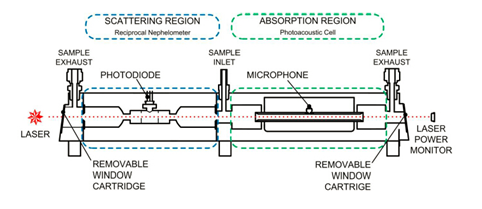Overview:
The Photoacoustic Extinctiometer (PAX) is a sensitive, high-resolution, fast-response instrument for measuring aerosol optical properties relevant for climate change and carbon particle sensing. The instrument directly measures in-situ light absorption and scattering of aerosol particles, from which it derives extinction, single scattering albedo and black carbon (soot) mass concentration. With no filter collection required, and consequently no filter-media artifacts, the PAX provides a highly accurate measure of absorption from black carbon.
Principle:
The PAX uses a modulated diode laser to simultaneously measure light scattering and absorption. The standard 870-nm wavelength is especially sensitive to black carbon particles, since there is relatively little absorption from gases and non-BC aerosol species at this wavelength. PAX laser wavelength options:
»» Red (870 nm) – absorption is highly specific for black carbon (soot) particles; scattering best for large particles
»» Green (532 nm) – measures in the visual range, typically what the human eye observes
A 1 L/min aerosol sample flow is drawn into the PAX using an internal vacuum pump controlled by two critical orifices. The flow is split between the nephelometer and photoacoustic resonator for simultaneous measurement oflight scattering and absorption. The absorption measurement uses in-situ photoacoustic technology. A laser beam directed through the aerosol stream is modulated at the resonant frequency of the acoustic chamber. Absorbing particles heat up and quickly transfer heat to the surrounding air. The periodic heating produces pressure waves that can be detected with a sensitive microphone. The system then determines the resonator quality factor and resonance frequency, which are needed to quantitatively determine aerosol light absorption. Phase-sensitive detection is used or all sensors. The PAX uses a wide-angle integrating reciprocal nephelometer to measure the light scattering coefficient. The scattering measurement responds to all particle typesregardless of chemical makeup, mixing state, ormorphology.

Figure 1 Schematic of the PAX instrument